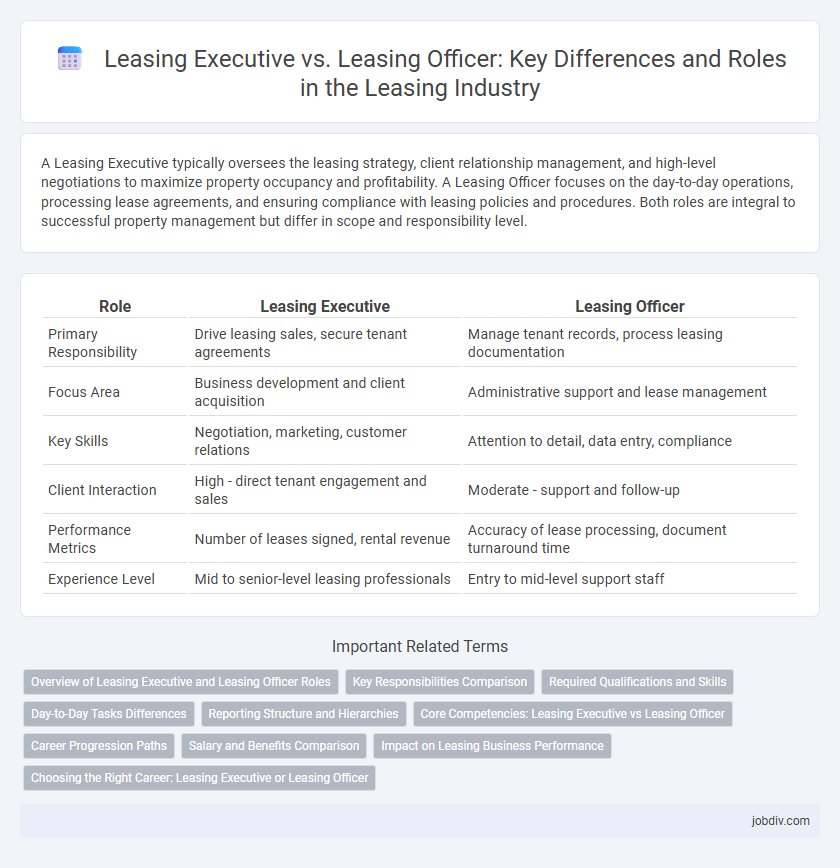A Leasing Executive typically oversees the leasing strategy, client relationship management, and high-level negotiations to maximize property occupancy and profitability. A Leasing Officer focuses on the day-to-day operations, processing lease agreements, and ensuring compliance with leasing policies and procedures. Both roles are integral to successful property management but differ in scope and responsibility level.
Table of Comparison
| Role | Leasing Executive | Leasing Officer |
|---|---|---|
| Primary Responsibility | Drive leasing sales, secure tenant agreements | Manage tenant records, process leasing documentation |
| Focus Area | Business development and client acquisition | Administrative support and lease management |
| Key Skills | Negotiation, marketing, customer relations | Attention to detail, data entry, compliance |
| Client Interaction | High - direct tenant engagement and sales | Moderate - support and follow-up |
| Performance Metrics | Number of leases signed, rental revenue | Accuracy of lease processing, document turnaround time |
| Experience Level | Mid to senior-level leasing professionals | Entry to mid-level support staff |
Overview of Leasing Executive and Leasing Officer Roles
Leasing Executives primarily focus on developing client relationships, negotiating lease terms, and driving sales strategies to maximize property occupancy and revenue. Leasing Officers are responsible for screening applicants, processing lease agreements, and ensuring compliance with leasing policies and regulations. Both roles collaborate closely to facilitate efficient leasing operations but differ in their emphasis on business development versus administrative execution.
Key Responsibilities Comparison
A Leasing Executive primarily focuses on developing leasing strategies, managing client relationships, and negotiating lease agreements to maximize occupancy and revenue. A Leasing Officer concentrates on property showings, application processing, tenant screening, and facilitating lease renewals to ensure smooth leasing operations. Both roles require strong communication skills, but the Executive role emphasizes strategic planning while the Officer role is more operational.
Required Qualifications and Skills
Leasing Executives typically require strong sales experience, excellent negotiation skills, and a proven track record in client relationship management, often supported by a bachelor's degree in business or real estate. Leasing Officers generally need in-depth knowledge of leasing laws, contract management skills, and attention to detail, with preferred qualifications including certifications in property management or real estate. Both roles demand effective communication skills, proficiency in leasing software, and the ability to analyze market trends for successful lease agreements.
Day-to-Day Tasks Differences
Leasing Executives primarily focus on generating new leasing opportunities through client outreach, negotiating lease terms, and closing deals, often involving strategic marketing efforts. Leasing Officers handle tenant relations by processing lease applications, coordinating move-ins and move-outs, and ensuring compliance with lease agreements and property policies. While Leasing Executives drive business growth, Leasing Officers maintain operational efficiency and tenant satisfaction through administrative and support functions.
Reporting Structure and Hierarchies
A Leasing Executive typically holds a more senior position within the leasing hierarchy, often responsible for strategic decision-making and overseeing multiple leasing officers or agents. Leasing Officers usually report directly to Leasing Executives, managing day-to-day leasing activities and tenant relations under their guidance. The reporting structure establishes clear accountability, with Leasing Executives monitoring performance metrics and ensuring alignment with organizational leasing goals.
Core Competencies: Leasing Executive vs Leasing Officer
Leasing Executives excel in strategic client acquisition, market analysis, and contract negotiation, leveraging strong communication and sales skills to maximize property lease value. Leasing Officers focus on operational tasks, such as tenant screening, compliance monitoring, and lease administration, requiring attention to detail and organizational proficiency. Both roles demand expertise in real estate regulations, customer relationship management, and effective problem-solving to ensure successful lease transactions.
Career Progression Paths
Leasing Executives primarily focus on client acquisition and relationship management, developing sales strategies to drive property occupancy. Leasing Officers typically handle operational tasks such as lease document processing, tenant screening, and compliance monitoring. Career progression often advances from Leasing Officer roles, which build foundational knowledge, to Leasing Executive positions that emphasize strategic leasing initiatives and leadership opportunities within real estate firms.
Salary and Benefits Comparison
Leasing Executives typically earn higher salaries than Leasing Officers, with average annual incomes ranging from $50,000 to $70,000 compared to $40,000 to $55,000 for Officers. Executives often receive enhanced benefits packages, including performance bonuses, comprehensive health insurance, and stock options, reflecting their advanced responsibilities in client acquisition and property management. Leasing Officers usually have standard benefits such as vacation leave and basic health coverage but fewer incentives tied to sales performance.
Impact on Leasing Business Performance
Leasing Executives drive strategic client acquisition and relationship management, significantly enhancing portfolio growth and occupancy rates. Leasing Officers focus on operational efficiency, ensuring timely lease processing and tenant satisfaction to reduce vacancy periods. Together, their roles optimize leasing business performance by balancing strategic expansion with effective lease administration.
Choosing the Right Career: Leasing Executive or Leasing Officer
Leasing Executives focus on strategic client acquisition, contract negotiation, and portfolio growth, making them suitable for professionals seeking a dynamic role with higher responsibility and earning potential. Leasing Officers handle day-to-day operations, tenant relations, and lease documentation, ideal for individuals preferring a structured role with direct customer interaction and administrative tasks. Evaluating career goals, skill sets, and work preferences helps in choosing between a Leasing Executive's strategic influence and a Leasing Officer's operational expertise.
Leasing Executive vs Leasing Officer Infographic

 jobdiv.com
jobdiv.com